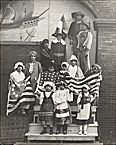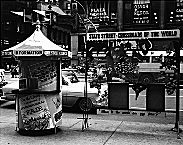|
Chicago Commons Pageant, 1924

|
Long before the word "globalization" entered popular speech, Chicago was a global city. This status meant simply that residents traveled, communicated, and conducted business internationally, and thus influenced and were influenced by concepts and events occurring outside national borders. Technological developments made such participation easier and faster, but did not initiate Chicagoans' global connectivity. Before the city even existed, the area around the southwestern shore of Lake Michigan was part of a network of trade and migration that stretched beyond the region and across the Atlantic Ocean. Fueled by technical innovations like the mechanical reaper, steam engine, electric motor, and telegraph, as well as commercial innovations like grain grading and futures markets, Chicagoans expanded their international reach. They traveled and traded across borders, seeking to control or at least take advantage of global channels of cultural and commercial exchange. Recent technologies, including satellite-based communications, microprocessors, and the internet, increased public awareness of trends that had already been shaping the region for centuries.
International Fair and Exposition, 1959

|
At the beginning of the twenty-first century, organizations such as World Business Chicago (established in 1999) promoted policies to address the benefits and challenges brought to the metropolitan region by globalization and the expanding international economy. In 2006, Mayor Richard M. Daley sought to bolster the city's image as a "top tier" global metropolis by promoting Chicago as host for the 2016 Olympic Games. Careful observers noted historical precedents for such efforts. World Business Chicago had a precursor in the Chicago Council on Global Affairs. Founded in 1922 as the Chicago Council on Foreign Relations, the Council continued its educational efforts into the twenty-first century. Other predecessors included the Chicago Association of Commerce and Industry (later known as the Chicagoland Chamber of Commerce), with its annual Chicago International Fair (beginning in the 1950s) that sought to promote trade and commercial activity based in the Chicago region. Daley's and local business leaders' support for the Olympics mirrored efforts of earlier generations of civic leaders who spearheaded drives to host the 1893 World's Columbian Exposition, 1904 Olympic Games (which were awarded to Chicago and then moved to St. Louis in conjunction with the world's fair), and 1959 Pan American Games.
Golden Gloves Program, 1938

|
While city leaders sought to shape conceptions of the city, other forces contributed to Chicago's international notoriety. From Al Capone to Michael Jordan, Haymarket Square to Hull-House, the 1871 fire to the 1968 National Democratic Convention, images of the midwestern metropolis crossed borders more readily than goods or people. Depictions of Chicago arose in unexpected places, as in the 1996 mayoral campaign in Vienna, Austria, when a candidate decried rising crime rates with the slogan, "Vienna Must Not Become Chicago." The swift response attributed to Mayor Daley—"It would be the same as if we criticized the population of Vienna saying it was full of Nazis"—reflected not only a defense of his hometown, but also awareness of the significance of image in international affairs, and the rapidity with which depictions could spread in the "information age."
This digital essay (actually two primary essays, two maps, and hundreds of historical sources) explores these historical precedents and provides context for current conceptions of Chicago as a global metropolis. "Globalization: Chicago and the World" analyzes the evolution of the area's inter-regional and inter-national connections—from seventeenth-century migration patterns, trade relations, and diplomacy, to Chicago's present status as the world's third largest internet exchange point. How have these global connections and the international exchange of people, culture, capital, goods, and ideas shaped life in the Chicago metropolitan region? How has this exchange influenced the world?
Janice L. Reiff, Professor of History at the University of California, Los Angeles, first envisioned and proposed a multi-component analysis of Chicago's global identity. Michael Conzen, Professor and Chair of the Committee on Geographical Studies at the University of Chicago, authored much of the text and maps that serve as the core elements of this digital essay, and participated in the original conception of the piece. Gary L. Johnson, president of the Chicago History Museum, contributed his analysis of Chicago as a global city. Finally, the project could not have been implemented without the generous financial support of the Dr. Scholl Foundation.
Sarah S. Marcus
|


